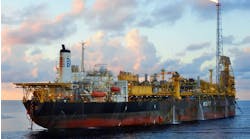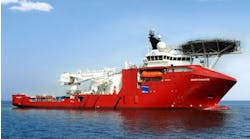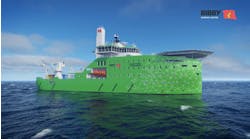Contributed by Inmarsat
As a response to the maritime industry’s growing appetite for data to serve sustainability and crew-welfare imperatives, shipowners in the offshore support vessel (OSV) sector are increasing bandwidth and adopting value-added services as their digitalization journey progresses and their requirements evolve.
The digitalization of the shipping industry, itself driven by environmental and crew-welfare imperatives alongside technological advancement and growing competition, is resulting in a significant increase in vessel data consumption.
According to latest Inmarsat statistics, monthly average total network usage in the maritime sector was 44.68% higher at the halfway point of 2022 than in 2021. If overall demand for bandwidth from shipowners is growing fast, however, demand in the offshore vessel sector is even stronger. Here, Inmarsat logged a 46.79% growth in network use over the same period.
To continue meeting the demand, offshore vessel connectivity solutions must also evolve, to support long-term efforts toward decarbonization and the improvement of crew welfare.
Digital decarbonization driving data use
The current increase in data use in the OSV sector is in part a reflection of the offshore industry’s ambitions to achieve greener and more efficient operations. As tightening environmental regulations encourage owners and operators to monitor the performance of their ships and shipboard equipment—and adopt digital solutions to analyze and act on the insights gleaned—bandwidth demands are soaring.
The process of capturing large quantities of data from numerous shipboard and external sources, storing and analyzing these data, and then transferring it to various stakeholders is now an established part of OSV operations and one that plays an integral role in decision-making for many companies. Similarly, digital solutions that allow owners to enhance efficiency in areas such as route/voyage planning and fuel consumption are now a common feature aboard vessels.
Monitoring performance and running advanced, cloud-based applications necessitate high network stability and considerable bandwidth. As ships become more digitally mature, with a greater number of advanced applications, these requirements continue to grow.
Crew welfare high on the agenda
In an increasingly digitalized, connected maritime environment, it is not only vessels becoming more dependent on data, but also the crew on board.
Since the onset of the COVID-19 pandemic, several high-profile incidents have drawn attention to the difficulties facing seafarers, with the infamous crew-change crisis depriving shipboard personnel of timely shore leave and repatriation. Many owners and managers have responded to this situation by investing in better connectivity for crew and offering access to digital services such as 24-hour helplines.
This trend, along with the now-mandatory requirement for seafarer connectivity recognized by the Maritime Labour Convention, has contributed to a 50% increase in total crew network use in the last year.
The moral issue aside, paying crew welfare the attention it deserves is a prudent business decision for owners and operators. With seafarers today comparing employers on their ability to provide fast and reliable Wi-Fi and deliver high-quality online services, connectivity is now essential to an OSV operator’s competitiveness.
Remote, automated and data-intensive
Another trend contributing toward the current rise in data consumption is the increasing use of technology to enable remote and automated processes.
In modern offshore operations, the vessel is coming to represent an extension of its operator’s headquarters—a floating operations center that must maintain contact with shore-based offices and other ships at all times.
For many owners, email services alone are no longer sufficient. Video conferencing, a particularly data-intensive activity, is a cornerstone of today’s connected fleet and has contributed to a 32% increase in monthly average network usage across maritime and offshore operations from 2021 to 2022 (as of June).
Similarly prevalent in modern shipping, and especially useful to offshore asset uptime, are remote inspections and maintenance, with companies looking to reduce costs and downtime by allowing vessel inspection and equipment servicing at sea. Like the use of automated processes that reduce the burden on crew and the risk of human error, remote servicing has clear benefits but also considerable bandwidth requirements.
An integrated and modular tool
Inmarsat’s Fleet Xpress Enhanced connectivity service draws on a secure and reliable satellite network, enabling owners to upgrade their bandwidth allowance and adopt new applications as their needs change.
Inmarsat partners are provided with a platform to deliver their value-added services and host applications, with shipping companies in turn gaining access to an array of functionality ranging from email and basic office tools to the latest IoT-powered solutions.
On Nov. 30, Inmarsat reached an agreement with offshore services provider Zamil Offshore to roll out an IoT solution to more than 60 vessels in the Gulf area.
The solution, powered by Fleet Connect and Fleet Data delivered through Inmarsat’s Fleet Xpress, will allow Zamil to identify, trial and select the best solutions to meet vessel performance expectations set by its charterer, Saudi Aramco. The announcement follows a successful trial on the fleet’s anchor tug, Zamil 57.
Saudi Aramco is contributing to Saudi Vision 2030, a strategic framework that aims to reduce Saudi Arabia’s dependence on oil and diversify its economy. This means Aramco needs deeper insight and control over the performance of its chartered ships, including those piloted by Zamil.
Inmarsat said Fleet Connect will provide the dedicated bandwidth to support vessel CCTV capabilities and other value-added services, while Fleet Data will power enhanced data analytics for efficiency and sustainability.
11.30.2022




